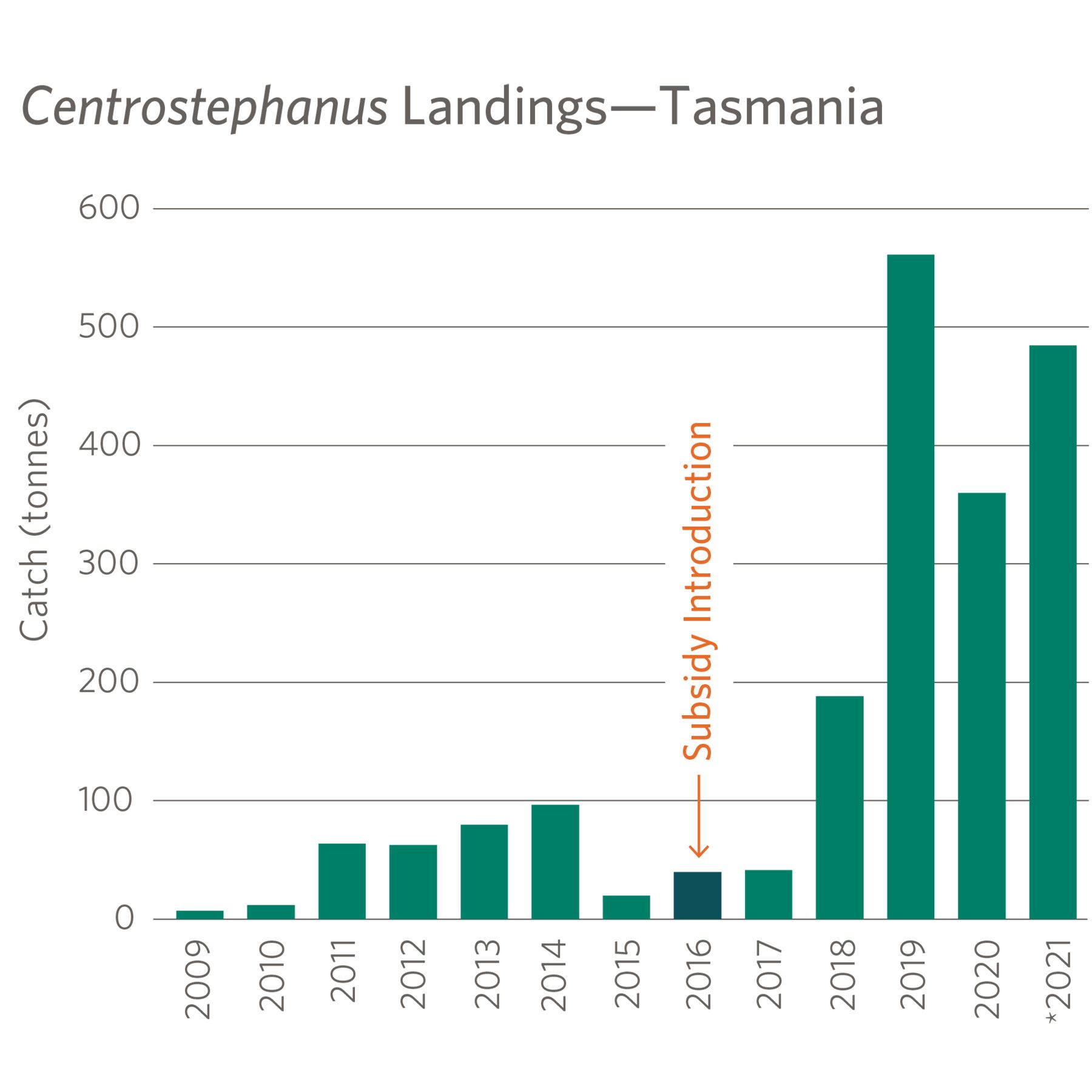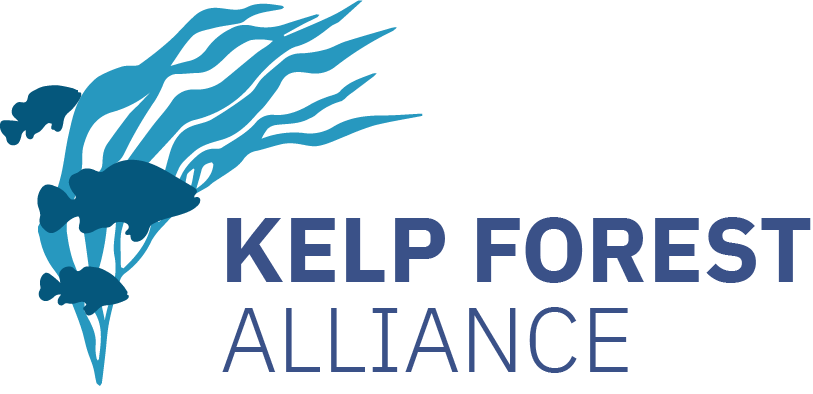Key takeaways
An urchin fishery was established to provide financial incentives to control a range-extending and destructive urchin species.
Spatially discrete subsidies and modified harvesting strategies were used to manage and optimise harvests efforts, with the long-term aims of facilitating industry stability and natural kelp recovery.
Background
Due to chronic coastal warming, the long-spined sea urchin (Centrostephanus rodgersii) has extended its range south from New South Wales to eastern Tasmania where it is causing widespread overgrazing of productive kelp forests 1 2 3; see Figure 1. Since first detection at St. Helens in 1978 (Fig. 1), the population of Centrostephanus in Tasmania reached ~20 million individuals by 2017 4. Importantly, when local urchin populations build to more than ~700 grams/m2 (or ~2.2 urchins/ m2), productive kelp forests are overgrazed and urchin barrens ensue; in contrast, only less than ~70 grams/m2 (or ~0.3 urchins/m2) is required to maintain barrens, with this hysteresis effect making recovery of kelp very difficult once barrens have formed 4. Prior to invasive urchin establishment, urchin barrens, as formed by the native urchin (Heliocidaris erythrogramma), were rare and highly localized (Ling et al. 2010). Driven by invasive urchin overgrazing, by 2001 urchin barrens constituted ~5% of eastern Tasmanian reefs (sites 1-9, Fig. 1) and had reached ~15% by 2016/17 5. That is, 95% of coastal reefs in eastern Tasmania were dominated by kelp forests in 2001/02, declining to 85% by 2016/17. Based on current trajectories of unmitigated population growth, Centrostephanus threatens to form barrens across ~50% of nearshore reefs in eastern Tasmania (sites 1-9) by ~2030 6. Collapse of kelp forests at this scale would further reduce productivity of lucrative Tasmanian abalone and lobster fisheries, plus continue wholesale collapse of biodiversity associated with kelp forests 7. Here we summarise three diver-based methods of urchin control.
The project
The commercial harvest of long-spined sea urchin began in Tasmania in 2009, with harvest progressing at low to moderate levels. Limiting the industry was the lack of urchin processing knowledge and export quality processing facilities, as well as concerns about the overall profitability. From 2016, the Tasmanian Abalone Council and the state government under the Abalone Industry Reinvestment Fund (AIRF) provided harvest subsidies at a value of $0.75/kg to accelerate the urchin harvest with the objective to protect and restore key kelp habitat for blacklip abalone (Haliotis rubra) and southern rock lobster (Jasus edwardsii). The subsidy gave confidence in the commercial processing industry to invest in sea urchin processing infrastructure, and, following private investment, catches rose from an average of 50 t/year to 180 t in 2018, followed by 560 t in 2019. The fishery now averages landings of over 460 t/year (2019 to 2021; Fig. 2). These harvest levels are approximately twice the rate of historical annual (unfished) biomass increase 8, and if sustained into the future are expected to place significant downward pressure on local urchin populations. Localised areas of kelp recovery at the heavily fished shallow (10-14 m depth) fringing kelp margins of extensive barren grounds are becoming apparent (Fig. 2a; pers. obs.).
Figure 1 Commercial fishery landings of long-spined Ssa urchin in Tasmania since the commencement of the fishery in 2009
Photo provided by the author.
To spatially direct the urchin fishing effort, variable subsidies were introduced mid-2019 and now range between $0 and $2.50/kg. The spatially structured subsidy has resulted in a shift in fishing effort and has enhanced urchin removal in regions deemed ecologically or commercially important. Average catch rates of the commercial harvest vary between 190 and 300 kg/hr (~475 – 750 individuals), depending on barren patch density 9. The retainment of small urchins on reefs is a potential limitation of the harvest fishery as a kelp restorative measure, since long-spined sea urchins at a test diameter of <85 mm are considered uneconomical to process and are not removed by fishers. While kelp recovery in some areas has been observed, high abundances of small urchins appear to be maintaining barrens in others, particularly boulder reefs (pers. obs.).
To overcome small urchins maintaining barrens, a ‘take-all’ harvest initiative supported by the AIRF has been trialled. A ‘take-all’ harvest is defined by divers taking all size-classes of urchins, not just those suitable for roe processing. Funded by the Tasmanian government, the first ‘take-all’ harvest removed 34.7 t of long-spined sea urchin at a cost of $101K ($2.90 /kg) from incipient barrens in southeast Tasmania in May 2020 10. The trial involved 16 divers over 13 harvest days and covered 82 hectares of reef, removing urchins at a rate of 491/hr. The region was reported to have ~4% urchin barren, consisting of low-density incipient urchin barrens with relatively higher numbers of small urchins (Fig. 2b), in 2017 11. The region was uneconomical to fish under normal operations but was assisted by the ‘take-all’ trial aimed at preventing further barren expansion in productive abalone ground. Of the 34.7 t harvested, 66% of the biomass (50% by number of urchins) was processed by industry and the roe sold to market.
Urchin culling (i.e., the killing of urchins underwater by divers) is a proven method to facilitate localized kelp regrowth within short time periods (~18 months) 12 13 14. Similar to ‘take-all’ harvesting, the method removes all size classes of urchins from the system. Commercial culling activities were conducted by commercial fishers in incipient barren areas adjacent to the abovementioned take-all harvest in 2019/2020 and funded by the state government. Cull rates and associated costs of cull activities were equivalent to that of catch rates from the take-all harvest 15. Diver culling rates increase as the barren type increases from incipient to extensive, and they have been reported as high as 2200 urchins/hr on extensive barren grounds 16.
Lessons learned
The establishment of a large-scale sea urchin harvest industry requires the development of substantial knowledge and intellectual property pertaining to the processing of roe for high-end consumer markets, as well as significant financial investment in facilities to meet export standards. Acknowledging these two critical limitations from the onset of a fishery, and providing means to overcome them, will facilitate rapid fishery development, put downward pressure on intensive sea urchin grazing, and hopefully contribute to kelp recovery. In Tasmania, a harvest subsidy provided the processing sector with confidence to invest in infrastructure, as well as take early financial hits while acquiring knowledge, in order to develop a large-scale export industry. Such a subsidy from the onset of the fishery could have fast-tracked the industry by up to 10 years. A sustainable sea urchin fishery intertwined with targeted take-all culling activities appears to be the most feasible and cost-effective means to control sea urchins and facilitate kelp recovery, and they are the subject of ongoing research and management.
References
17 Cresswell, K., J. P. Keane, E. Ogier, E. and S. Yamazaki. 2019. Centrostephanus Subsidy Program: Initial Evaluation. Institutute for Marine and Antarctic Studies. University of Tasmania. 26 p.
18 Larby, S. 2020. ‘Take all’ harvest trial of Longspined sea urchin (Centrostephanus rodgersii). Marion Bay to Cape Hauy. Tasmanian Commercial Divers Association. 28 p.
19 Ling, S. 2008. Range expansion of a habitat-modifying species leads to loss of taxonomic diversity: a new and impoverishe d reef state. Oecologia 156:883-894.
20 Ling, S., C. Johnson, S. Frusher, and K. Ridgway. 2009. Overfishing reduces resilience of kelp beds to climate-driven catastrophic phase shift. Proceedings of the National Academy of Sciences 106:22341-22345.
21 Ling, S. D., and J. P. Keane. 2018. Resurvey of the Longspined Sea Urchin (Centrostephanus rodgersii) and associated barren reef in Tasmania. Institutute for Marine and Antarctic Studies. University of Tasmania. 52 p.
22 Ling, S. D., R. E. Scheibling, A. Rassweiler, C. R. Johnson, N. Shears, S. D. Connell, A. K. Salomon, K. M. Norderhaug, A. Pérez-Matus, J. C. Hernández, S. Clemente, L. K. Blamey, B. Hereu, E. Ballesteros, E. Sala, J. Garrabou, E. Cebrian, M. Zabala, D. Fujita, and L. E. Johnson. 2015. Global regime shift dynamics of catastrophic sea urchin overgrazing. Phil. Trans. R. Soc. B370:20130269.
23 Sanderson, J.C., Ling, S.D., Dominguez, J.G. and Johnson, C.R., 2015. Limited effectiveness of divers to mitigate ‘barrens’ formation by culling sea urchins while fishing for abalone. Marine and Freshwater Research, 67(1), pp.84-95.
24 Tracey, S.R., Baulch, T., Hartmann, K., Ling, S.D., Lucieer, V., Marzloff, M.P. and Mundy, C., 2015. Systematic culling controls a climate driven, habitat modifying invader. Biological Invasions, 17(6), pp.1885-1896.
Figure 2 (a) Early signs of macroalgal regrowth on incipient barrens at 12 m depth at the heavily harvested site of Sloop Rock (St. Helens), March 2019. (b) Incipient barren in southeast Tasmania (Forestier Peninsula) where subsidised harvesting has been in effect (up to $2.50 /kg), and where ~35 tons of urchins were harvested in 2020 as part of a ‘take-all’ harvest strategy. Photos provided by the authors.






